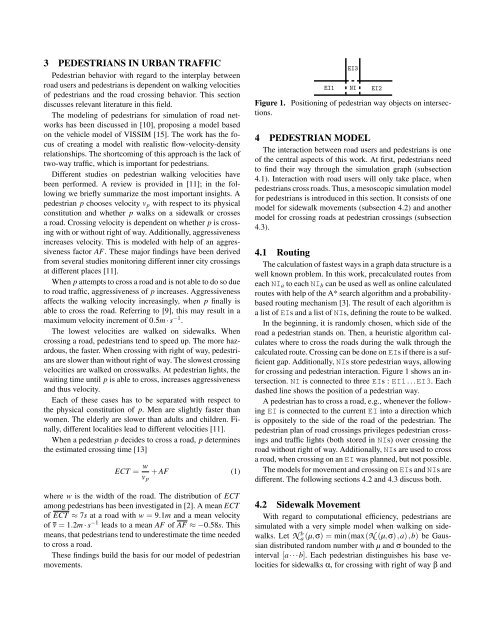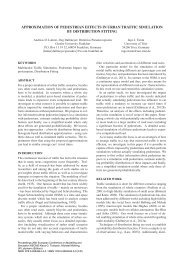Pedestrian Simulation for Urban Traffic Scenarios
Pedestrian Simulation for Urban Traffic Scenarios
Pedestrian Simulation for Urban Traffic Scenarios
You also want an ePaper? Increase the reach of your titles
YUMPU automatically turns print PDFs into web optimized ePapers that Google loves.
3 PEDESTRIANS IN URBAN TRAFFIC<br />
<strong>Pedestrian</strong> behavior with regard to the interplay between<br />
road users and pedestrians is dependent on walking velocities<br />
of pedestrians and the road crossing behavior. This section<br />
discusses relevant literature in this field.<br />
The modeling of pedestrians <strong>for</strong> simulation of road networks<br />
has been discussed in [10], proposing a model based<br />
on the vehicle model of VISSIM [15]. The work has the focus<br />
of creating a model with realistic flow-velocity-density<br />
relationships. The shortcoming of this approach is the lack of<br />
two-way traffic, which is important <strong>for</strong> pedestrians.<br />
Different studies on pedestrian walking velocities have<br />
been per<strong>for</strong>med. A review is provided in [11]; in the following<br />
we briefly summarize the most important insights. A<br />
pedestrian p chooses velocity vp with respect to its physical<br />
constitution and whether p walks on a sidewalk or crosses<br />
a road. Crossing velocity is dependent on whether p is crossing<br />
with or without right of way. Additionally, aggressiveness<br />
increases velocity. This is modeled with help of an aggressiveness<br />
factor AF. These major findings have been derived<br />
from several studies monitoring different inner city crossings<br />
at different places [11].<br />
When p attempts to cross a road and is not able to do so due<br />
to road traffic, aggressiveness of p increases. Aggressiveness<br />
affects the walking velocity increasingly, when p finally is<br />
able to cross the road. Referring to [9], this may result in a<br />
maximum velocity increment of 0.5m · s −1 .<br />
The lowest velocities are walked on sidewalks. When<br />
crossing a road, pedestrians tend to speed up. The more hazardous,<br />
the faster. When crossing with right of way, pedestrians<br />
are slower than without right of way. The slowest crossing<br />
velocities are walked on crosswalks. At pedestrian lights, the<br />
waiting time until p is able to cross, increases aggressiveness<br />
and thus velocity.<br />
Each of these cases has to be separated with respect to<br />
the physical constitution of p. Men are slightly faster than<br />
women. The elderly are slower than adults and children. Finally,<br />
different localities lead to different velocities [11].<br />
When a pedestrian p decides to cross a road, p determines<br />
the estimated crossing time [13]<br />
ECT = w<br />
+ AF (1)<br />
vp<br />
where w is the width of the road. The distribution of ECT<br />
among pedestrians has been investigated in [2]. A mean ECT<br />
of ECT ≈ 7s at a road with w = 9.1m and a mean velocity<br />
of v = 1.2m · s −1 leads to a mean AF of AF ≈ −0.58s. This<br />
means, that pedestrians tend to underestimate the time needed<br />
to cross a road.<br />
These findings build the basis <strong>for</strong> our model of pedestrian<br />
movements.<br />
Figure 1. Positioning of pedestrian way objects on intersections.<br />
4 PEDESTRIAN MODEL<br />
The interaction between road users and pedestrians is one<br />
of the central aspects of this work. At first, pedestrians need<br />
to find their way through the simulation graph (subsection<br />
4.1). Interaction with road users will only take place, when<br />
pedestrians cross roads. Thus, a mesoscopic simulation model<br />
<strong>for</strong> pedestrians is introduced in this section. It consists of one<br />
model <strong>for</strong> sidewalk movements (subsection 4.2) and another<br />
model <strong>for</strong> crossing roads at pedestrian crossings (subsection<br />
4.3).<br />
4.1 Routing<br />
The calculation of fastest ways in a graph data structure is a<br />
well known problem. In this work, precalculated routes from<br />
each NIa to each NIb can be used as well as online calculated<br />
routes with help of the A* search algorithm and a probabilitybased<br />
routing mechanism [3]. The result of each algorithm is<br />
a list of EIs and a list of NIs, defining the route to be walked.<br />
In the beginning, it is randomly chosen, which side of the<br />
road a pedestrian stands on. Then, a heuristic algorithm calculates<br />
where to cross the roads during the walk through the<br />
calculated route. Crossing can be done on EIs if there is a sufficient<br />
gap. Additionally, NIs store pedestrian ways, allowing<br />
<strong>for</strong> crossing and pedestrian interaction. Figure 1 shows an intersection.<br />
NI is connected to three EIs : EI1...EI3. Each<br />
dashed line shows the position of a pedestrian way.<br />
A pedestrian has to cross a road, e.g., whenever the following<br />
EI is connected to the current EI into a direction which<br />
is oppositely to the side of the road of the pedestrian. The<br />
pedestrian plan of road crossings privileges pedestrian crossings<br />
and traffic lights (both stored in NIs) over crossing the<br />
road without right of way. Additionally, NIs are used to cross<br />
a road, when crossing on an EI was planned, but not possible.<br />
The models <strong>for</strong> movement and crossing on EIs and NIs are<br />
different. The following sections 4.2 and 4.3 discuss both.<br />
4.2 Sidewalk Movement<br />
With regard to computational efficiency, pedestrians are<br />
simulated with a very simple model when walking on sidewalks.<br />
Let N b a (µ,σ) = min(max(N (µ,σ),a),b) be Gaussian<br />
distributed random number with µ and σ bounded to the<br />
interval [a···b]. Each pedestrian distinguishes his base velocities<br />
<strong>for</strong> sidewalks α, <strong>for</strong> crossing with right of way β and



